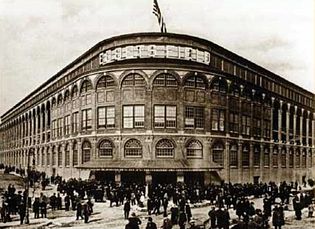Ebbets Field
 |
|
| Location | 55 Sullivan Place Brooklyn, New York City, New York 11225 |
|---|---|
| Coordinates | 40°39′54″N 73°57′29″W / 40.66500°N 73.95806°WCoordinates: 40°39′54″N 73°57′29″W / 40.66500°N 73.95806°W |
| Owner |
Brooklyn Dodgers (1913–1956) Marvin Kratter (1956–1957) |
| Operator | Brooklyn Dodgers |
| Capacity | 18,000 (1913) 30,000 (1914–1923) 26,000 (1924–1925) 28,000 (1926–1931) 32,000 (1932–1936) 35,000 (1937–1945) 34,219 (1946–1949) 32,111 (1949–1954) 31,902 (1955–1957) |
| Field size | Left field: 348 ft Left-center: 351 ft Center field: 395 ft Right-center: 344 ft Right field: 297 ft |
| Surface | Grass |
| Construction | |
| Broke ground | March 4, 1912 |
| Opened | April 9, 1913 |
| Closed | September 24, 1957 |
| Demolished | February 23, 1960 |
| Construction cost | US$750,000 ($18.2 million in 2017 dollars) |
| Architect | Clarence Randall Van Buskirk |
| General contractor | Castle Brothers, Inc. |
| Tenants | |
|
Brooklyn Dodgers (MLB) (1913–1957) New York Brickley Giants (NFL) (1921) Brooklyn Lions (NFL) (1926) Brooklyn Dodgers / Tigers (NFL) (1930–1944) Brooklyn Tigers (AFL) (1936) Brooklyn Dodgers (AAFC) (1946–1948) |
|
Ebbets Field was a Major League Baseball stadium in the Flatbush section of Brooklyn, New York City. It is known mainly as the home of the Brooklyn Dodgers baseball team of the National League, from 1913 to 1957, but was also home to three National Football League teams in the 1920s.
Ebbets Field was demolished in 1960 and replaced by apartment buildings.
Ebbets Field was bounded by Bedford Avenue on the east, Sullivan Place on the South, Cedar Street (renamed McKeever Place in 1932) on the west, and Montgomery Street on the north. After locating the prospective new site to build a permanent stadium to replace the old, wooden Washington Park, Dodgers' owner Charles Ebbets acquired the property over several years, starting in 1908, by buying lots until he owned the entire block. The land included the site of a garbage dump called Pigtown, because of the pigs that once ate their fill there and the stench that filled the air. Even at the groundbreaking, the site was described as containing several old houses, shanties, goats, and tomato cans, and although the streets bordering the field were mapped, two of them had not been built yet. Construction began on March 4, 1912, and the cornerstone, a piece of Connecticut granite that held newspapers, pictures of baseball players, cards, telegrams, and almanacs was laid on July 6, 1912. At the cornerstone laying ceremony, Ebbets said that the ballpark was going to be ready for play on September 1, and that Brooklyn was going to win the National League pennant in 1913. Neither happened. On August 29, 1912, as the deadline drew near and it was obvious that the ballpark was not even close to being finished, it was announced that Ebbets had sold shares in the team to Stephen W. and Edward J. McKeever, who had built their fortune in contracting and were able to speed along the construction to make up for an iron workers' strike during the summer. This turned out to be a sale of 50% of the team, which led to management troubles years, later, but by early 1913, Pigtown had been transformed into Ebbets Field, where some of baseballs's greatest dramas took place.
...
Wikipedia
